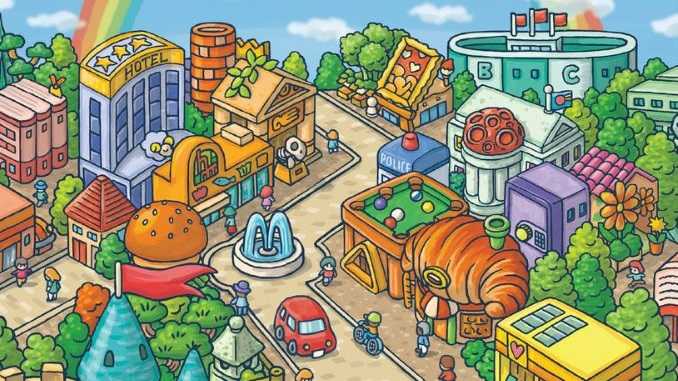The Cute, Family-Friendly Board Game Happy City Could Be a Gateway to More Complex Games
Games Reviews board games
Happy City is every bit as cute as it sounds, from the art to the tiny cards to the simple concept: Build the happiest city you can in 10 cards (or fewer). Combining a common theme with a bunch of familiar mechanics, and one slightly novel one, it’s a fast-playing family game that can also teach kids a little bit about math as you go.
Each player in Happy City starts with one card, a Happy Market, that provides income of 1 coin per turn; in the basic game, all market cards are the same, while in the advanced game, each has a unique color (one of five). At the start of each round, players receive income shown on the cards they’ve already built, and then may buy one building card from the market. Most cards either give you one or more hearts, representing happiness, or people, representing your population. Your point total at the end of the game is equal to the product of those two numbers—so yes, there will be some math in Happy City.
The building cards come in three piles, separated by cost, ranging from 1-3 coins in the first pile, 4-5 in the second, and 6-9 in the third. On your turn, you may draw cards from any pile until there are three showing in the market; you can also discard one card that was already face-up when your turn began. You then have the choice to buy one of the cards that’s face-up; to buy a single green housing card (always available) for 1, 2, or 3 coins; or to take 1 coin as extra income. You may not build the same building twice, however, so you can’t just buy up a bunch of green cards—they’re there to make sure no one is unable to buy for two turns in a row.
The game also includes bonus cards, two separate sets depending on whether you’re playing the base game or the advanced game. The basic bonus cards are simple to use: once you have buildings matching the colors shown on the top of a bonus card—say, one orange, one green, and one purple—in your city, you may claim the bonus card for free. These bonus cards show additional hearts and/or people, and take up one space in your city just like any other card. The cards in the advanced deck are more sophisticated, and can give you immediate bonuses, game-end benefits, or some combination of both, so that you might tailor your whole strategy around getting one such card, both before you get it and after, to maximize its power. That does put the advanced game beyond the reach of the youngest players, who might be fine with the arithmetic in the base game but would need help thinking more holistically about how best to use one of those cards. You can only have one bonus card in your city, however, whether you’re playing with the basic or advanced decks.
If you’ve played Machi Koro, you probably have some of the gist of Happy City, although this game dispenses with the dice that I think made Machi Koro more frustrating than anything else, and here you’re not dealing with probabilities, just with the constraints of the three cards available on each turn. There are some similarities to Splendor as well—the three-tiered card setup is familiar, although you don’t have so many cards on display and can’t plan ahead in the way you can with Splendor, but the bonus cards in the basic game do feel very Splendorish. I could see this as a stepping-stone towards that game, where kids who get the hang of Happy City could ‘graduate’ to that game. The one aspect that sets Happy City apart from similar tableau-builders is the fact that you multiply the two factors (happiness and population) to get your score—there’s a lesson in there about balance that challenges younger players in a way that can also sharpen their mental math skills. The highest product you’ll get for any total number of hearts and people is a perfect square, when those two variables are equal. For example, if you have 14 total hearts and people, the highest point score you can get is 49, if you have 7 of each; split up 14 any other way and you will get a lower total score. It’s a bit like the scoring in Tigris & Euphrates, which demands balance rather than encouraging it, done more simply for the younger crowd.
The short play time—the box says 30 minutes, but with two players you can probably do it in half that time—and limitations on long-term strategy make this more of a light family game, or a quick filler on the road since the game itself is so portable, rather than one for the gamers in the crowd. I’d also ignore the “ages 10+” recommendation on the box, as I played this with my 8-year-old stepdaughter and she had no problem at all with the rules, while she absolutely loved the theme and artwork and wanted to play again immediately after we finished our first go. It’s a great starter game if, like me, you have a secret plan to turn every one of your children into hardcore gamers by the time they can drive.
Keith Law is the author of The Inside Game and Smart Baseball and a senior baseball writer for The Athletic. You can find his personal blog the dish, covering games, literature, and more, at meadowparty.com/blog.